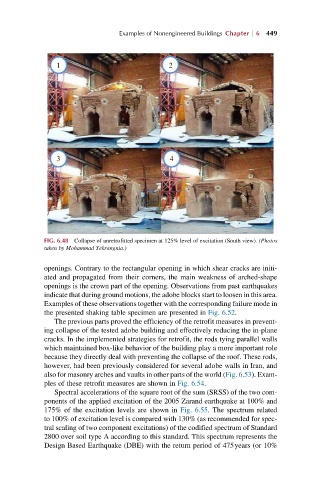Page 506 - Advanced Design Examples of Seismic Retrofit of Structures
P. 506
Examples of Nonengineered Buildings Chapter 6 449
1 2
3 4
FIG. 6.48 Collapse of unretrofitted specimen at 125% level of excitation (South view). (Photos
taken by Mohammad Yekrangnia.)
openings. Contrary to the rectangular opening in which shear cracks are initi-
ated and propagated from their corners, the main weakness of arched-shape
openings is the crown part of the opening. Observations from past earthquakes
indicate that during ground motions, the adobe blocks start to loosen in this area.
Examples of these observations together with the corresponding failure mode in
the presented shaking table specimen are presented in Fig. 6.52.
The previous parts proved the efficiency of the retrofit measures in prevent-
ing collapse of the tested adobe building and effectively reducing the in-plane
cracks. In the implemented strategies for retrofit, the rods tying parallel walls
which maintained box-like behavior of the building play a more important role
because they directly deal with preventing the collapse of the roof. These rods,
however, had been previously considered for several adobe walls in Iran, and
also for masonry arches and vaults in other parts of the world (Fig. 6.53). Exam-
ples of these retrofit measures are shown in Fig. 6.54.
Spectral accelerations of the square root of the sum (SRSS) of the two com-
ponents of the applied excitation of the 2005 Zarand earthquake at 100% and
175% of the excitation levels are shown in Fig. 6.55. The spectrum related
to 100% of excitation level is compared with 130% (as recommended for spec-
tral scaling of two component excitations) of the codified spectrum of Standard
2800 over soil type A according to this standard. This spectrum represents the
Design Based Earthquake (DBE) with the return period of 475years (or 10%

